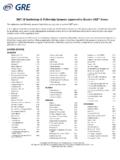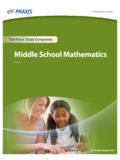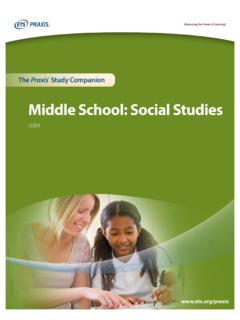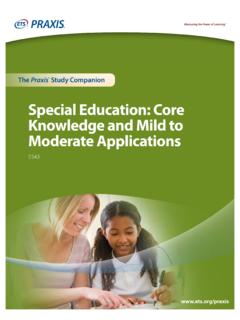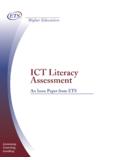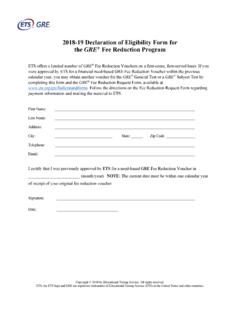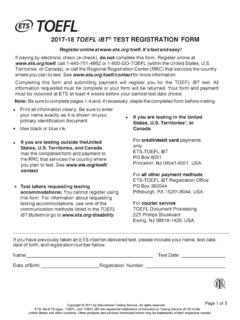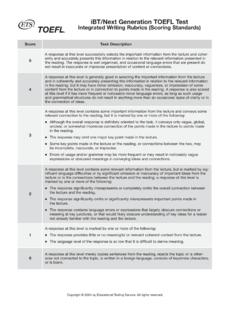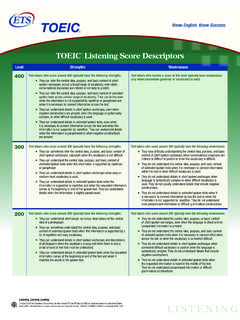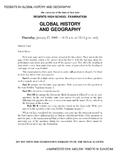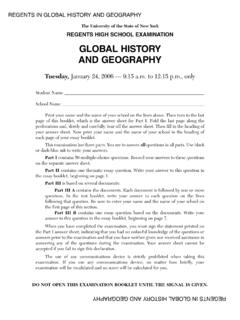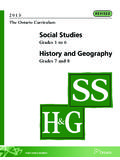Transcription of World and U.S. History: Content Knowledge Study …
1 The Praxis Study Companion World and history : Content Knowledge 5941. Welcome to the Praxis Study Companion Welcome to the Praxis Study Companion Prepare to Show What You Know You have been working to acquire the Knowledge and skills you need for your teaching career. Now you are ready to demonstrate your abilities by taking a Praxis test. Using the Praxis Study Companion is a smart way to prepare for the test so you can do your best on test day. This guide can help keep you on track and make the most efficient use of your Study time. The Study Companion contains practical information and helpful tools, including: An overview of the Praxis tests Specific information on the Praxis test you are taking A template Study plan Study topics Practice questions and explanations of correct answers Test-taking tips and strategies Frequently asked questions Links to more detailed information So where should you start?
2 Begin by reviewing this guide in its entirety and note those sections that you need to revisit. Then you can create your own personalized Study plan and schedule based on your individual needs and how much time you have before test day. Keep in mind that Study habits are individual. There are many different ways to successfully prepare for your test. Some people Study better on their own, while others prefer a group dynamic. You may have more energy early in the day, but another test taker may concentrate better in the evening. So use this guide to develop the approach that works best for you. Your teaching career begins with preparation. Good luck! Know What to Expect Which tests should I take? Each state or agency that uses the Praxis tests sets its own requirements for which test or tests you must take for the teaching area you wish to pursue.
3 Before you register for a test, confirm your state or agency's testing requirements at How are the Praxis tests given? Praxis tests are given on computer. Other formats are available for test takers approved for accommodations (see page 45). The Praxis Study Companion 2. Welcome to the Praxis Study Companion What should I expect when taking the test on computer? When taking the test on computer, you can expect to be asked to provide proper identification at the test center. Once admitted, you will be given the opportunity to learn how the computer interface works (how to answer questions, how to skip questions, how to go back to questions you skipped, etc.) before the testing time begins. Watch the What to Expect on Test Day video to see what the experience is like. Where and when are the Praxis tests offered?
4 You can select the test center that is most convenient for you. The Praxis tests are administered through an international network of test centers, which includes Prometric Testing Centers, some universities, and other locations throughout the World . Testing schedules may differ, so see the Praxis web site for more detailed test registration information at www. The Praxis Study Companion 3. Table of Contents Table of Contents The Praxis Study Companion guides you through the steps to success 1. Learn About Your Learn about the specific test you will be taking 2. F. amiliarize Yourself with Test 14. Become comfortable with the types of questions you'll find on the Praxis tests 3. Practice with Sample Test 18. Answer practice questions and find explanations for correct answers 4. Determine Your Strategy for 27.
5 Set clear goals and deadlines so your test preparation is focused and efficient 5. Develop Your Study 30. Develop a personalized Study plan and schedule 6. Review Study 34. Review Study topics with questions for discussion 7. Review Smart Tips for 43. Follow test-taking tips developed by experts 8. Check on Testing 45. See if you qualify for accommodations to take the Praxis test 9. Do Your Best on Test 46. Get ready for test day so you will be calm and confident 10. Understand Your 48. Understand how tests are scored and how to interpret your test scores Appendix: Other Questions You May Have .. 50. The Praxis Study Companion 4. Step 1: Learn About Your Test 1. Learn About Your Test Learn about the specific test you will be taking World and history : Content Knowledge (5941). Test at a Glance Test Name World and history : Content Knowledge Test Code 5941.
6 Time 2 hours Number of Questions 120. Format Selected-response questions Test Delivery Computer delivered Approximate Approximate Content Categories Number of Percentage of Questions Examination IV I I. World history to 1450 30 25%. II. World history : 1450 to the Present 30 25%. III. United States history to 1877 30 25%. III II IV. United States history : 1877 to the Present 30 25%. V. Historical Thinking Skills* 30* 25%*. * Includes historical thinking skills questions in Categories I IV. About This Test The World and history : Content Knowledge test is for prospective teachers of World and United States history in secondary schools. The test is aligned to the National Council for the Social Studies (NCSS) National Standards for Social Studies Teachers. The 120 selected-response questions assess Knowledge of historical facts and processes across the Content areas of World and United States history .
7 Approximately 50 percent of the questions deal with World history , and approximately 50 percent of the questions deal with United States history . Some questions will also assess understanding of historical thinking skills, such as knowing how to formulate historical questions, knowing how to evaluate primary and secondary sources, knowing how to construct and support historical arguments, knowing how to make connections across time and geography , knowing how to assess historical causation, and knowing how to place historical events and processes in a global context. Some questions are based on interpreting material such as written passages, maps, charts, graphs, tables, cartoons, diagrams, and/or photographs. The 120 questions are equally weighted. Questions are selected-response with four answer choices and written according to ETS guidelines.
8 This test may contain some questions that will not count toward your score. The Praxis Study Companion 5. Step 1: Learn About Your Test Test Specifications Test specifications in this chapter describe the Knowledge and skills measured by the test. Study topics to help you prepare to answer test questions can be found on page 34. Note: The test and the outline that follows use the chronological designations (before the common era). and (common era). These labels correspond to (before Christ) and (anno Domini), which are used in some World history texts. PERCENTAGES REFER TO PERCENT OF WHOLE TEST D. The formation, organization, significance of, and interactions among the civilizations of Greece, Rome, Persia, I. World history to 1450 (25%) India, and China in the period 1000. A. World geography and how global climatic 500 (1 8%).
9 And environmental factors shape human 1. Demonstrate understanding of the formation, history (1 3%) organization and significance of the 1. Identify the location of major historical events civilizations of Greece, Rome, Persia, India, and China in the period 1000 500 2. Demonstrate Knowledge of how global climatic and environmental factors shaped 2. Demonstrate understanding of the human history interactions among the civilizations of Greece, Rome, Persia, India, and China in the period B. The characteristics and structures of 1000 500 hunting-and-gathering societies and the shift that occurred with the Neolithic 3. Compare and contrast the civilizations of Revolution, circa 8000 (1 5%) Greece, Rome, Persia, India, and China in the period 1000 500 1. Understand the major differences between hunting-and-gathering societies and E.
10 The origin, tenets, development, agricultural societies significance, and spread of Hinduism, Confucianism, Buddhism, Judaism, 2. Identify the Neolithic Revolution and its Christianity, and Islam (1 8%). consequences 1. Demonstrate understanding of the main C. The formation, organization, and beliefs of Hinduism, Confucianism, Buddhism, significance of early river valley Judaism, Christianity, and Islam civilizations in Afro-Eurasia in the period 8000 1000 , and in Mesoamerica 2. Demonstrate understanding of where, how, and South America in the period 2000 and when Hinduism, Confucianism, Buddhism, 1500 (1 8%) Judaism, Christianity, and Islam originated and developed 1. Demonstrate understanding of the formation, organization, and significance of early river 3. Demonstrate understanding of how and why valley civilizations ( , Mesopotamia, Egypt, major religions spread Indus River Valley).
